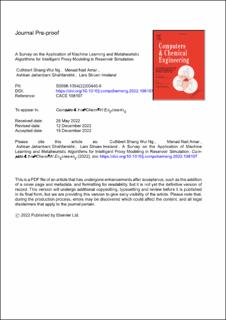| dc.contributor.author | Ng, Cuthbert Shang Wui | |
| dc.contributor.author | Nait Amar, Menad | |
| dc.contributor.author | Jahanbani Ghahfarokhi, Ashkan | |
| dc.contributor.author | Imsland, Lars Struen | |
| dc.date.accessioned | 2022-12-27T13:49:57Z | |
| dc.date.available | 2022-12-27T13:49:57Z | |
| dc.date.created | 2022-12-19T09:16:29Z | |
| dc.date.issued | 2022 | |
| dc.identifier.issn | 0098-1354 | |
| dc.identifier.uri | https://hdl.handle.net/11250/3039565 | |
| dc.description.abstract | Machine Learning (ML) has demonstrated its immense contribution to reservoir engineering, particularly reservoir simulation. The coupling of ML and metaheuristic algorithms illustrates huge potential for application in reservoir simulation, specifically in developing proxy models for fast reservoir simulation and optimization studies. This is conveniently termed the coupled ML-metaheuristic paradigm. Generally, proxy modeling has been extensively researched due to the expensive computational effort needed by traditional Numerical Reservoir Simulation (NRS). ML and the abovementioned coupled paradigm are effective in establishing proxy models. We conduct a survey on the employment of ML and the coupled paradigm in proxy modeling of NRS. We present the respective successful applications as reported in the literature. The benefits and limitations of these methods in intelligent proxy modeling are briefly explained. We opine that some study areas, including sampling techniques and dimensionality reduction methods, are worth investigating as part of the future research development of this technology. | en_US |
| dc.language.iso | eng | en_US |
| dc.publisher | Elsevier | en_US |
| dc.rights | Navngivelse 4.0 Internasjonal | * |
| dc.rights.uri | http://creativecommons.org/licenses/by/4.0/deed.no | * |
| dc.title | A Survey on the Application of Machine Learning and Metaheuristic Algorithms for Intelligent Proxy Modeling in Reservoir Simulation | en_US |
| dc.title.alternative | A Survey on the Application of Machine Learning and Metaheuristic Algorithms for Intelligent Proxy Modeling in Reservoir Simulation | en_US |
| dc.type | Peer reviewed | en_US |
| dc.type | Journal article | en_US |
| dc.description.version | acceptedVersion | en_US |
| dc.source.journal | Computers and Chemical Engineering | en_US |
| dc.identifier.doi | https://doi.org/10.1016/j.compchemeng.2022.108107 | |
| dc.identifier.cristin | 2094951 | |
| cristin.ispublished | false | |
| cristin.fulltext | postprint | |
| cristin.qualitycode | 2 | |

